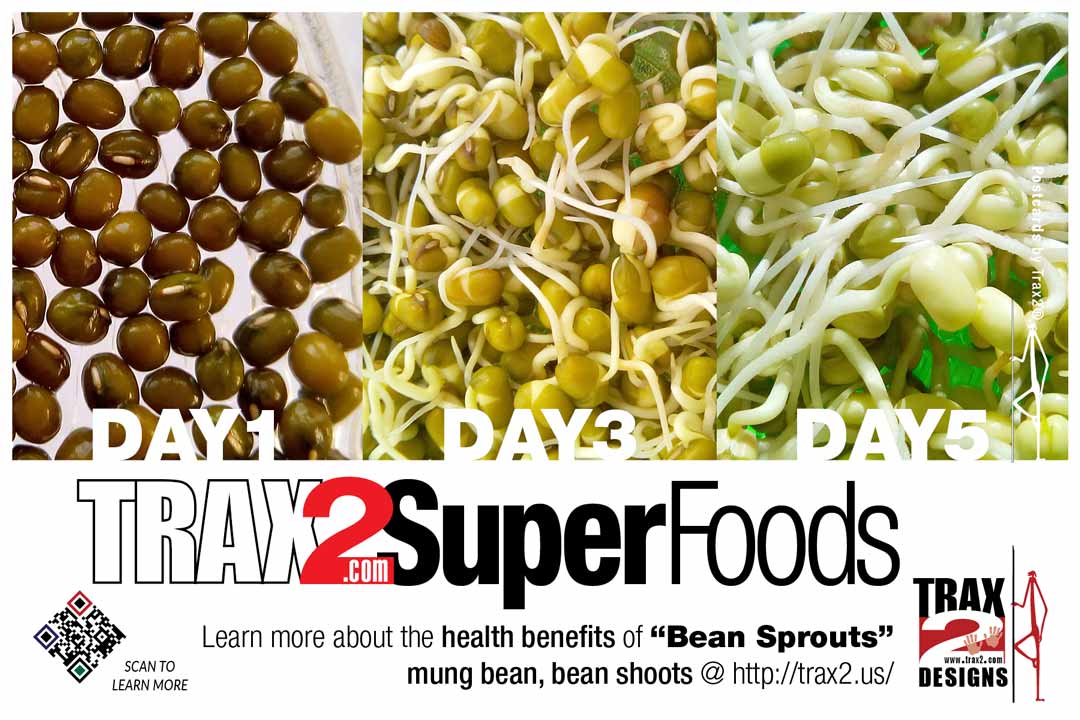Trax2 Bean Sprouts
When people talk about bean sprouts, most people think of mung bean sprouts, the most commonly used seed for growing bean sprouts.
However there are many other varieties of beans and seeds that can also be sprouted, including alfalfa seeds, sunflower seeds, kidney beans, white beans, peas, lentils and adzuki beans.
In general terms, bean sprouts are the tender, edible shoots of certain bean plants. They are the result of the germination process, through which the nutritive ingredients found in beans and seeds become profoundly modified: starch is converted into glucose and fructose, bean proteins are predigested by specific seed enzymes and transformed into amino acids and more digestible protein nutrients, the water content increases, as well as the vitamin and mineral content does.
Bean sprouts have been used for centuries for their nutritional and medical benefits. They can be eaten raw or lightly cooked or they can be juiced. Flavor varies from sweet delicate to sharp intense, depending on the type of sprout.
Nutritional Benefits
Bean sprouts are a true concentrate of energy and nutritive principles. Unlike ripe vegetables, whose nutritional value progressively decreases after they have been harvested, bean sprouts retain their nutritional properties until consumed.
Bean sprouts have the richest source of amino acids (for protein), vitamins and minerals, and also contain a good amount of fiber. They contain all types of vitamins (A, B, C, D, E and K), folate and are an excellent source of iron, potassium, calcium, phosphorous, magnesium and zinc.
Other nutritional benefits vary depending on the type of sprout. It is interesting to note that mung bean sprouts contain estrogen-like phytochemicals, called isoflavones, which are responsible for some of the many healthy proprieties of these sprouts.
Health Benefits (See 8 essential amino acids cheat sheet)
Sprouts from all beans and/or seeds are so high in highly digestible nutrients, vitamins and minerals that can be considered true multi-ingredient natural supplements. However, here we will focus on the health benefits of mung bean sprouts, which are the most commonly consumed sprouts all over the world and the most studied by researchers.
Anemia:
Mung bean sprouts (as well as other types of bean sprouts) are rich in iron, which play a key role in the synthesis of hemoglobin, the protein found in red blood cells. They are also particularly high in vitamin C, which enhances the absorption of iron from the intestine, thereby helping prevent or treat anemia caused by iron deficiency.
Cardiovascular health:
When associated with a low intake of saturated fats (found in meat, poultry and dairy products), the regular consumption of mung bean sprouts can help reduce the blood levels of LDL-cholesterol due to its content in fiber and lecithin. This effect is beneficial to the heart and vessels, since it helps prevent the development of atherosclerosis, the most common cause of cardiovascular disease.
Constipation:
Due to their high content in fiber, mung bean sprouts can help improve intestinal motility and relieve the signs of constipation.
Hair and nail fragility:
Hair and nail fragility is often the result of certain nutritional deficiencies, especially proteins, vitamins and zinc. Mung bean sprouts contain high amounts of all these nutrients in a readily available form, and hence they are particularly helpful in preventing and treating hair and nail problems.
Liver health:
Mung bean sprouts are an excellent source of lecithin which, besides lowering blood cholesterol levels, helps reduce liver fat, thereby preventing fatty liver, a common liver condition that can result in liver dysfunction.
Skin anti-aging effect:
It has been shown that phytoestrogens found in mung bean sprouts act on certain estrogen-receptors found in the skin, stimulating the synthesis of hyaluronic acid, collagen and elastin, which are vital components of the skin?s structure. Therefore, the regular consumption of mung bean sprouts can help prevent many age-related skin changes, including elasticity and moisture loss.
Stress and tiredness:
Mung bean sprouts are a source of readily available energy and other nutrients which are particularly helpful in fighting the signs and symptoms of mental and physical stress and tiredness.
Consumption Tips
Most sprouts can be eaten raw; and if cooking them, saut? very lightly or just a quick blanch or light steam. Do not overcook. Whether raw or cooked, bean sprouts can be used in a variety of dishes, including appetizers, salads, side dishes and snacks.
They can be juiced, as well but usually added to other vegetable juices. To get used to their flavor, it is better to start with a handful of sprouts added to other green juices and then increase the amount depending on your taste.
Caution
Commercially produced raw sprouts have been associated with food-borne illnesses as the high levels of moisture and heat generated during the sprouting process may have been conducive to the growth of bacteria.
Always ensure that sprouts are kept at refrigerator temperature. Throw away sprouts that smell, have turned dark or are slimy. Rinse sprouts thoroughly with water before consumption.
Some people are allergic to the proteins found in certain legumes or legume sprouts, and hence they are recommended not to consume them at all.







